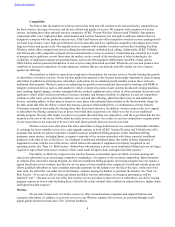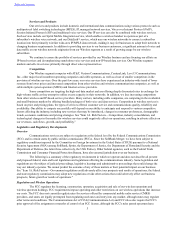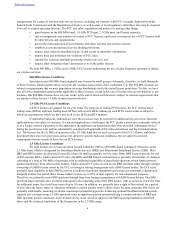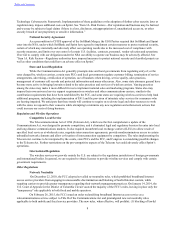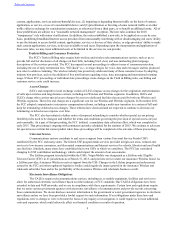Sprint - Nextel 2014 Annual Report Download - page 15
Download and view the complete annual report
Please find page 15 of the 2014 Sprint - Nextel annual report below. You can navigate through the pages in the report by either clicking on the pages listed below, or by using the keyword search tool below to find specific information within the annual report.
Table of Contents
13
Item 1A. Risk Factors
In addition to the other information contained in this annual report on Form 10-K, the following risk factors
should be considered carefully in evaluating us. Our business, financial condition, liquidity or results of operations could be
materially adversely affected by any of these risks.
If we are not able to retain and attract profitable wireless subscribers, our financial performance will be impaired.
Our success is based on our ability to retain current subscribers and attract new subscribers. If we are unable to
attract and retain profitable wireless subscribers, our financial performance will be impaired, and we could fail to meet our
financial obligations. From 2008 through March 31, 2015, we have experienced an aggregate net decrease of approximately
12.7 million million subscribers in our total retail postpaid subscriber base (excluding the impact of our acquisitions).
Our ability to retain our existing subscribers, to compete successfully for new subscribers, and reduce our churn
rate depends on, among other things:
• our ability to anticipate and respond to various competitive factors, including our successful execution of
marketing and sales strategies; the acceptance of our value proposition; service delivery and customer care
activities, including new account set up and billing; and execution under credit and collection policies;
• our successful deployment of new technologies and services;
• actual or perceived quality and coverage of our network;
• public perception about our brands;
• our ability to anticipate and develop new or enhanced technologies, products, and services that are attractive
to existing or potential subscribers;
• our ability to access additional spectrum; and
• our ability to maintain our current mobile virtual network operator (MVNO) relationships and to enter into
new MVNO arrangements.
Our ability to retain subscribers may be negatively affected by industry trends related to subscriber contracts.
Recently, we have seen aggressive customer acquisition efforts by our competitors. For example, most service providers are
offering wireless service plans without any long-term commitment. Furthermore, some service providers are reimbursing
contract termination fees, including paying off the outstanding balance on devices, incurred by new customers in connection
with such customers terminating service with their current wireless service providers. Our competitors’ aggressive customer
contract terms, such as those described above, could negatively affect our ability to retain subscribers and could lead to an
increase in our churn rates if we are not successful in providing an attractive product, price, and service mix.
We expect to continue to incur expenses, such as subsidies, the reimbursement of subscriber termination fees, and
other subscriber acquisition and retention expenses, to attract and retain subscribers, but there can be no assurance that our
efforts will generate new subscribers or result in a lower churn rate. Subscriber losses and a high churn rate could adversely
affect our business, financial condition, and results of operations because they result in lost revenues and cash flow.
Moreover, we and our competitors continue to seek a greater proportion of new subscribers from each other’s
existing subscriber bases rather than from first-time purchasers. These new subscribers to the Company could include
customers with lower credit scores who have a higher delinquency risk. To the extent we cannot compete effectively for new
subscribers or if we attract more subscribers that are not creditworthy, our revenues and results of operations could be
adversely affected.
The success of our network improvements will depend on the timing, extent, and cost of implementation; access to
spectrum; the performance of third-parties and related parties; upgrade requirements; and the availability and reliability
of the various technologies required to provide such modernization.
We must continually invest in our wireless network in order to improve our wireless services and remain
competitive. The development and deployment of new technologies and services requires us to anticipate the changing
demands of our customers and to respond accordingly, which we may not be able to do in a timely or efficient manner.
Improvements in our service depend on many factors, including our ability to predict and adapt to future changes
in technologies, changes in consumer demands, changes in pricing and service offerings by our competitors, and continued
access to and deployment of adequate spectrum, including any leased spectrum. If we are unable to access spectrum to
increase capacity or to deploy the services subscribers desire on a timely basis or at acceptable costs while maintaining



